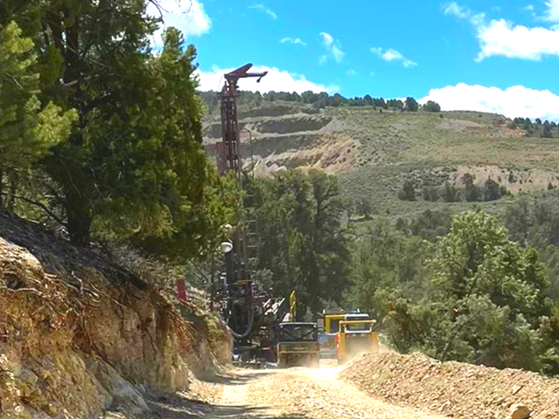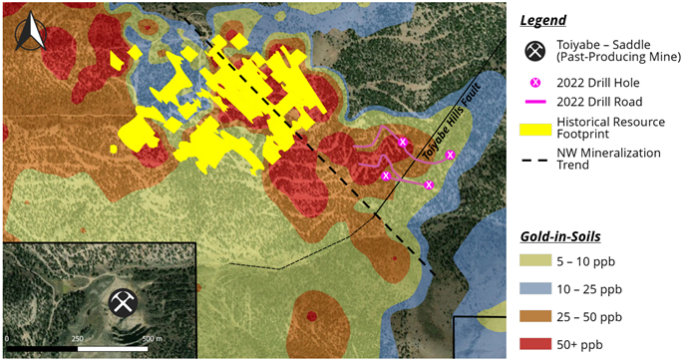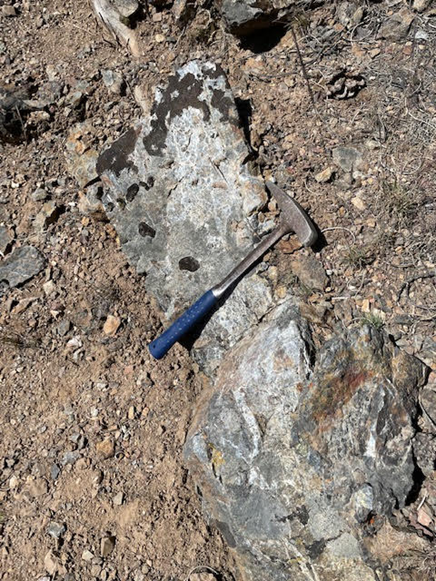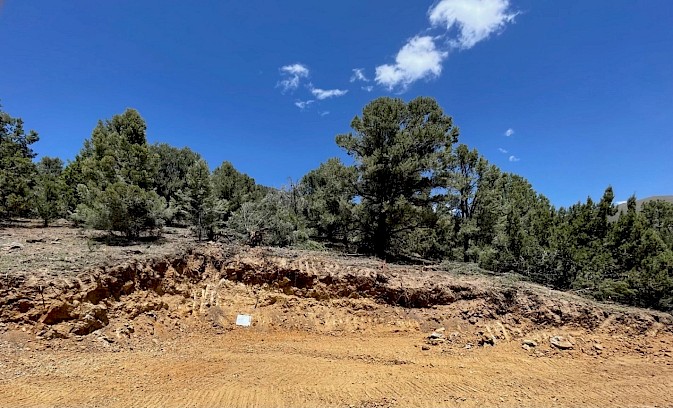Vancouver, British Columbia, June 22, 2022 – Westward Gold Inc. (CSE: WG, OTCQB: WGLIF, FSE: IM50) (“Westward” or the “Company”) is pleased to provide an update on the Company’s inaugural drill campaign, currently underway at its flagship Toiyabe Project in Lander County, Nevada (“Toiyabe”).
Drilling at the first of four target areas – the California Zone – has now been completed, with two holes reaching a depth of 1,000 feet / ~305 meters, and the third reaching a depth of 965 feet / ~295 meters (for additional details on the California Zone target, please refer to Westward’s press release dated June 8, 2022). The first batch of reverse-circulation chips from these holes have been sent to ALS Ltd. for analysis, and deliveries will continue in regular intervals as the campaign progresses.
Dave Browning, Westward’s VP Exploration, noted: “We’re very happy with the progress of the drilling in these early stages of the campaign. We’re beginning to see improved shift efficiencies at the rig, and expect this trend to continue over the coming days and weeks. Mobilization is now underway to our second target area – Toiyabe Hills North – where earthwork crews have been preparing roads and pads for the past week.”
Figure 1: Drilling at the California Zone (Past-Producing Toiyabe-Saddle Open Pit in Background)

Toiyabe Hills North Target Area
The Company’s second target area (Toiyabe Hills North) is situated to the east of the historical resource estimate at Toiyabe (~173 koz at 1.2 g Au/t)(1) (the “Historical Estimate”), approaching the boundary between Toiyabe and the Turquoise Canyon Project (also controlled by Westward). The four planned drillholes in the area will be collared in gold-in-soil anomalies, which trend southeast from the Historical Estimate; this mineralization trend is also present at the California Zone and is repeated across the Company’s ~39km2 land package. The target area has also shown elevated arsenic and mercury-in-soils (12 samples spaced 100 meters apart): arsenic – ranging from 23ppm to 210ppm; mercury – ranging from 90ppb to 220ppb. These elements are commonly associated with Carlin-type gold deposits in the region. Figure 2 below displays the approximate location of the four holes relative to the Historical Estimate, as well as the Toiyabe Hills Fault (the “TH Fault”), a key feature which influenced target selection and is detailed further below.
Figure 2: 2022 Toiyabe Drilling – Toiyabe Hills North Target Area

Toiyabe Hills Fault
The TH Fault is a dike-filled structural corridor, and is pervasively altered along the ~1.8km northeast strike length identified to date (~90m wide). Examples include Figure 3 below, which shows quartz stockwork breccia, and Figure 4, a target drill site cut exposing a clay-altered and oxidized igneous dike within the fault zone. The TH Fault is a key geological feature in the area, and the primary influence on the Company’s target selection. The TH Fault was first identified and mapped as part of Westward’s 2021 field program, and based on the Company’s review of available historical data, it was not tested in prior drill campaigns. Jasperoid (decalcified and silica-enriched lower-plate carbonate rock) is present along the fault strike; this alteration feature is commonly associated with Carlin-type gold deposits.
Figure 3: TH Fault – Quartz Stockwork Breccia

Figure 4: Target Drill Site Cut Exposing a Clay-Altered and Oxidized Igneous Dike within the TH Fault

It is believed that the TH Fault extends northeast from the northernmost open pit at the past-producing Toiyabe Saddle Mine, and the structure (referred to in the context of that mine as the “401 Fault”) was a key mineralization control for that deposit(2), and the fluid pathway controlling the observed igneous dikes and Carlin-style alteration. An induced-polarization study completed in 2021 identified anomalies which suggest the TH Fault / 401 Fault also intersects faults associated with the Historical Estimate. Investigating this structure – which may have played a vital role in the deposition of gold in the broader area – is one of the main goals of Westward’s 2022 drill campaign, and will inform future targeting efforts.
(1) Source: NI 43-101 Technical Report, American Consolidated Minerals Corporation, Prepared by Paul D. Noland, P. Geo., May 27, 2009 (the “2009 Technical Report”). A qualified person has not done sufficient work to classify the historical estimate at Toiyabe (the “Historical Estimate”) as current mineral resources and Westward is not treating the Historical Estimate on Toiyabe as a current mineral resource, as defined in National Instrument 43-101 – Standards of Disclosure for Mineral Projects (“NI 43-101”). The Historical Estimate was calculated using mining industry standard practices for estimating Mineral Resource and Mineral Reserves (2005) which was prior to the implementation of the current CIM standards for mineral resource estimation (as defined by the CIM Definition Standard on Mineral Resources and Ore Reserves dated May 10, 2014). The key assumptions, parameters and methods used to prepare the Historical Estimate on Toiyabe are described in the 2009 Technical Report. While Westward considers the Historical Estimate on Toiyabe disclosed in this news release to be relevant to investors, it cautions readers that it should not be unduly relied upon in drawing inferences on the mineralization on Toiyabe, as additional work is required to upgrade or verify the Historical Estimate as a current mineral resource. This additional work includes (but may not be limited to): re-sampling and re-assaying of available core and/or pulps, verification of assay certificates and digital assay data, verification of select drill hole collars, review and verification of drill hole geologic logs versus the preserved core and RC cuttings, incorporation of AuCN assays to provide a general understanding of metallurgical characteristics, review and verification of mineralization controls and modelling techniques.
(2) Source: “Geology and Gold Mineralization at the Toiyabe Project, Lander County, Nevada”, by Gavan Heinrich, published in the Annual Report for the Center for Research in Economic Geology, December 1998.
Qualified Person
The technical information contained in this news release was reviewed and approved by Steven R. Koehler, Technical Advisor to the Company, who is a Qualified Person under National Instrument 43-101 – Standards of Disclosure for Mineral Projects. Mr. Koehler is a Certified Professional Geologist (CPG) through the American Institute of Professional Geologists (AIPG).
About Westward Gold
Westward Gold is a mineral exploration company focused on developing the Toiyabe, Turquoise Canyon, and East Saddle Projects located in the Cortez Hills area of Lander County, Nevada. From time to time, the Company may also evaluate the acquisition of other mineral exploration assets and opportunities.
For further information contact:
Colin Moore
President, CEO & Director
Westward Gold Inc.
colin@westwardgold.com
Tel: +1 (647) 403 0391
www.westwardgold.com
The Canadian Securities Exchange has neither approved nor disapproved the contents of this news release. The Canadian Securities Exchange does not accept responsibility for the adequacy or accuracy of this news release.
This news release contains or incorporates by reference “forward-looking statements” and “forward-looking information” as defined under applicable Canadian securities legislation. All statements, other than statements of historical fact, which address events, results, outcomes, or developments that the Company expects to occur are, or may be deemed, to be, forward-looking statements. Forward-looking statements are generally, but not always, identified by the use of forward-looking terminology such as "expect", "believe", "anticipate", "intend", "estimate”, “potential”, “on track”, “forecast", "budget", “target”, “outlook”, “continue”, “plan” or variations of such words and phrases and similar expressions or statements that certain actions, events or results “may”, “could”, “would”, “might” or “will” be taken, occur or be achieved or the negative connotation of such terms.
Such statements include, but may not be limited to, information as to strategy, plans or future financial or operating performance, such as the Company’s expansion plans, project timelines, expected drilling targets, and other statements that express management’s expectations or estimates of future plans and performance.
Forward-looking statements or information are subject to a variety of known and unknown risks, uncertainties and other factors that could cause actual events or results to differ from those reflected in the forward-looking statements or information, including, without limitation, the need for additional capital by the Company through financings, and the risk that such funds may not be raised; the speculative nature of exploration and the stages of the Company’s properties; the effect of changes in commodity prices; regulatory risks that development of the Company’s material properties will not be acceptable for social, environmental or other reasons, availability of equipment (including drills) and personnel to carry out work programs, that each stage of work will be completed within expected time frames, that current geological models and interpretations prove correct, the results of ongoing work programs may lead to a change of exploration priorities, and the efforts and abilities of the senior management team. This list is not exhaustive of the factors that may affect any of the Company’s forward-looking statements or information. These and other factors may cause the Company to change its exploration and work programs, not proceed with work programs, or change the timing or order of planned work programs. Additional risk factors and details with respect to risk factors that may affect the Company’s ability to achieve the expectations set forth in the forward-looking statements contained in this news release are set out in the Company’s latest management discussion and analysis under “Risks and Uncertainties”, which is available under the Company’s SEDAR profile at www.sedar.com. Although the Company has attempted to identify important factors that could cause actual results to differ materially, there may be other factors that cause results not to be as anticipated, estimated, described or intended. Accordingly, readers should not place undue reliance on forward-looking statements or information. The Company’s forward-looking statements and information are based on the assumptions, beliefs, expectations, and opinions of management as of the date of this press release, and other than as required by applicable securities laws, the Company does not assume any obligation to update forward-looking statements and information if circumstances or management’s assumptions, beliefs, expectations or opinions should change, or changes in any other events affecting such statements or information
